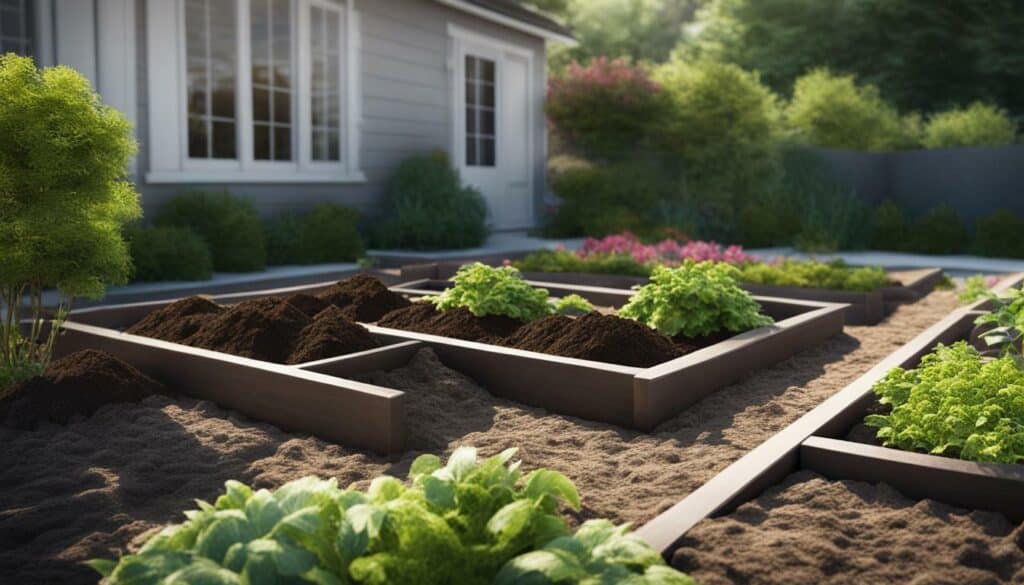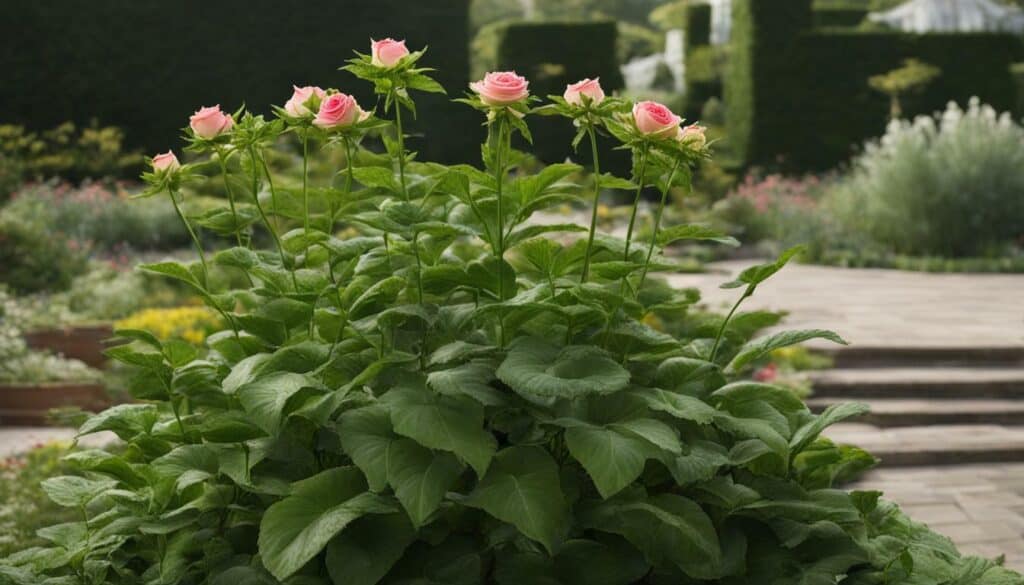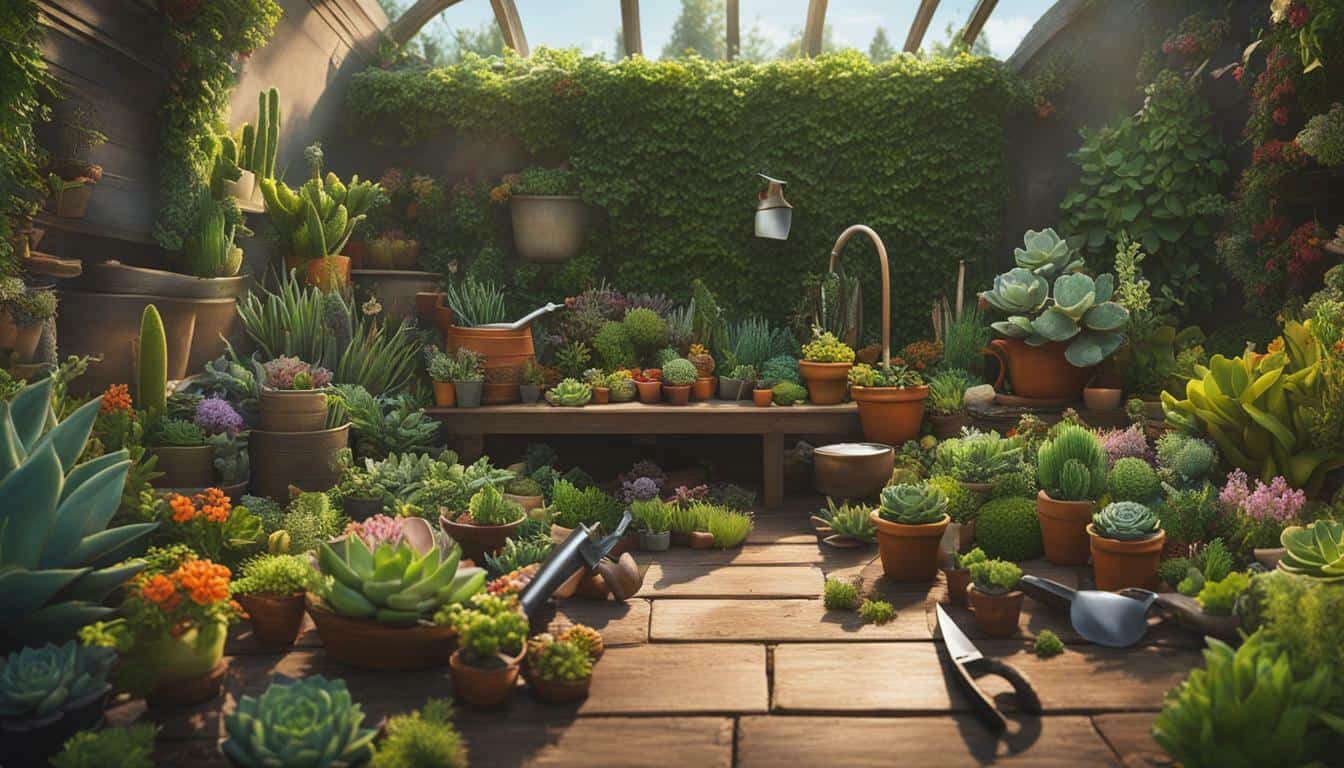Welcome to my comprehensive guide on essential gardening terms for beginners. Whether you’re new to gardening or just looking to expand your knowledge, understanding these terms will help you navigate the world of plants and cultivate your own green thumb.
When starting out in gardening, understanding common gardening terms can be the first step towards success. Here is a list of some of the most essential terms to help you get started:
Key Takeaways:
- Understanding essential gardening terms is crucial for beginner gardeners.
- Plant and seed terminology, soil terminology, and general gardening techniques are all important areas to focus on.
- By familiarizing yourself with these terms, you’ll have a better understanding of gardening catalogs, seed packages, and websites.
Annual
An annual is a plant that completes its life cycle within one year, from seed germination to flower production and seed formation. This makes them a popular choice for beginner gardeners who want to see quick results. Annual plants include common flowers such as marigolds, zinnias, and petunias. They are also often used in vegetable gardens for quick harvests, such as lettuce, radishes, and beans.
Understanding the plant life cycle is an important aspect of gardening for beginners. It helps to determine when to plant, prune, and fertilize plants. Annuals, as mentioned, complete their life cycle in one year. Biennials take two years to complete their life cycle, while perennials come back year after year.
| Annuals | Biennials | Perennials |
|---|---|---|
| Complete life cycle in one year | Complete life cycle in two years | Grow back year after year |
| Examples: Marigolds, Zinnias, Beans | Examples: Foxgloves, Parsley, Hollyhocks | Examples: Hostas, Daylilies, Peonies |
As a beginner gardener, it is important to understand the various gardening terms associated with plants. Knowing these terms will help you choose the right plants for your garden and care for them properly. Some other important terms to know include:
- Bolting: When a plant prematurely flowers and produces seeds, finishing its life cycle.
- Companion planting: Growing different plants together for mutual benefit.
- Deadheading: The removal of dead flowers to encourage new blooms.
- Determinate: Plants that grow in a bush-like shape and produce fruit all at once.
- Indeterminate: Plants that vine and produce fruit continuously.
- Germination: When a seed sprouts and starts to grow.
- Direct sowing: Planting seeds directly in the garden.
- Transplanting: Starting seeds indoors and moving them to the garden later.
- GMOs: Genetically modified organisms.
- Heirloom varieties: Old seeds that have fallen out of favor in industrial agriculture.
- Hardening off: The process of acclimating seedlings to the outdoor environment.
- Intensive planting: Getting more production from a small space.
- Seed scarification: Treating seeds to improve germination.

Bare Root
Bare root refers to plants that have been removed from the ground, with their soil completely removed, and stored without soil until they are ready for planting. This method is commonly used for transplanting trees, shrubs, and perennials, and is especially popular during the dormant season. Bare root plants offer several advantages for beginner gardeners, such as being cost-effective, easier to transport, and with the ability to establish quickly in the new location.
Before planting bare root plants, it is important to soak the roots in water to rehydrate them. It is recommended to do this for a few hours or overnight to ensure proper hydration. When planting bare root plants, it is essential to dig a hole that is wide and deep enough to accommodate the roots without bending or crowding them. Planting them too deep or shallow can cause problems with the establishment of the plant.
Dormant plants that have been stored as bare root specimens require proper care to ensure their successful establishment and growth. Watering regularly is crucial, particularly during the first year following planting. It is also important to protect bare root plants from extreme temperatures, such as hot winds or freezing temperatures, which can damage or kill them.

Overall, bare root plants are an excellent option for beginner gardeners looking to start a new garden or transplant existing plants. With proper care and attention, these plants can establish quickly and thrive in their new location.
Biennial
A biennial is a plant that completes its entire life cycle within two years, typically growing foliage in the first year and producing flowers and seeds in the second year. Examples of biennial plants include forget-me-nots, foxgloves, and sweet Williams. Biennial gardening requires understanding terms like deadheading, which is the removal of dead flowers to encourage new blooms, and transplantation, which involves moving plants from one location to another.
Beginner gardeners should also be aware of concepts such as bolting, which is when plants prematurely produce flowers or seeds due to stress, and companion planting, where different plants are grown together to benefit each other. It is important to know the difference between determinate and indeterminate plants, which differ in size, shape, and production habits.
Another crucial term is germination, which is the sprouting of a seed to begin growth. Direct sowing refers to planting seeds directly in the desired location, while transplanting involves starting seeds indoors and later moving them to the garden. It is also critical to be familiar with terms related to soil, such as fertilizer, pH, and organic matter, as well as various gardening techniques like scarification and hardening off.
Finally, it is worth noting that heirloom varieties are old breeds of plants that are no longer common in industrialized agriculture, and intensive planting is a method of maximizing production in a small gardening space.

Bolting
Bolting is the premature production of flowers or seeds by a plant instead of producing a crop, often caused by excessive heat and sun exposure. When a plant is stressed, it can divert its energy towards reproduction instead of growth, resulting in a decreased yield or even the death of the plant.

Bolting is a common problem for plants such as spinach and cilantro, which are typically grown in cool weather. It is important to monitor the weather conditions and harvest the plants before they bolt. In addition to bolting, there are several other gardening terms that beginners may find useful to understand.
Fertilizers are used to provide essential nutrients for plant growth, while garden soil is a mixture of sand, clay, and organic matter that provides a healthy environment for plants to grow.
Ground cover and mulch are used to protect the soil from erosion and retain moisture, while pruning is the process of removing dead or damaged parts of a plant to promote healthy growth.
Understanding the lifecycles of plants is also important for successful gardening. Annuals complete their life cycle in one growing season, while biennials take two years and perennials live for multiple years. Companion planting, deadheading, determinate vs indeterminate plants, germination, direct sowing vs transplanting, GMOs, hardening off, heirloom varieties, intensive planting, and seed scarification are all additional gardening terms that beginners should familiarize themselves with.
Botanical Name
The botanical name of a plant refers to its scientific name, which consists of the Genus and species, and is used to accurately identify and classify plants. This term is critical for beginner gardeners to understand because it allows them to communicate effectively with other gardeners and experts, as well as access accurate information from books, catalogs, and websites.
When exploring gardening websites or catalogs, beginners may notice that the same plant has different names depending on the source. The common name of a plant can vary based on geographical location or be colloquially named after a famous person. In contrast, the botanical name is standardized worldwide and is the same regardless of where the plant grows.
For instance, think about tomatoes. Gardeners generally refer to them as tomatoes, but they have a scientific name: Solanum lycopersicum. The first part, Solanum, refers to the genus, while lycopersicum indicates a particular species. When shopping for tomato plants or seeds online or in a store, it is essential to know the scientific name since different varieties may have distinct qualities that affect growth, size, and even taste.

Knowing the scientific names of plants also makes it easier to research pests, diseases, and how to care for specific plants. It helps identify which plants can grow well together based on their compatibility when planting in the same location. By familiarizing themselves with botanical names, beginner gardeners can confidently explore the vast world of gardening, sharing their knowledge with others, and making the most out of this rewarding hobby.
Deciduous
A deciduous plant is one that sheds its leaves during the fall or winter months, entering a period of dormancy until the next growing season. This term is important for beginner gardeners to understand because it helps them plan their gardens and understand the lifecycle of the plants they are working with.
Deciduous plants are typically trees or shrubs, but can also include some types of perennials. When the leaves fall off, the plant enters a period of rest, conserving energy until the warmer temperatures and longer days of spring return. This shedding of leaves is known as leaf shedding, and can be a great opportunity for gardeners to prune and shape their plants.

It is important to note that not all deciduous plants lose their leaves at the same time. Some may begin to shed leaves as early as late summer, while others may hold onto their leaves until well into the winter months. The timing can also depend on factors such as geographic location and weather conditions.
If you are new to gardening, it is helpful to understand which plants in your garden are deciduous so that you can plan accordingly. For example, if you have a deciduous tree or shrub that provides shade during the summer months, you may need to plant a different species nearby to provide shade during the winter months when the leaves have fallen.
In summary, understanding the term deciduous is important for beginner gardeners who want to plan their gardens and care for their plants. By knowing which plants are deciduous, you can prepare for leaf shedding and take advantage of the opportunity to prune and shape your plants.
Dormancy
Dormancy is the period of rest that plants go through, usually during winter, when their growth and metabolic activities slow down or temporarily cease. This is a natural process that occurs in response to a decrease in temperature, sunlight, and water availability. During dormancy, plants lose their leaves (deciduous plants) or keep their leaves throughout the season (evergreen plants). Understanding dormancy is highly important for beginner gardeners, as it helps them determine the appropriate time to prune, fertilize, and water their plants.
Bare root plants are typically dormant plants that have been removed from the ground and preserved until later planting. These are plants that have been dug out while they are in their dormant state and sold without soil around their roots. Bare root plants are cost-effective and are an excellent option for gardeners who want to start their garden from scratch or add new plants to their existing ones.
It’s essential to know when a plant is dormant to avoid pruning or fertilizing during this period. Doing so may stress the plant and disrupt its growth cycle. For instance, pruning a tree during dormancy may result in an excessive growth of new branches once the tree wakes up from its rest period. Similarly, fertilizing during this period may encourage the plant to grow new shoots that may later freeze if the frost season is not yet over.

Gardeners should also note that dormant plants have a lower water requirement than active plants. Therefore, watering should be reduced or stopped altogether during this phase. Over-watering during dormancy may lead to waterlogging, which may cause the roots to rot.
In conclusion, dormancy is a natural process that occurs during winter, when plants go through a period of rest, slowing down their growth and metabolic activities. Beginner gardeners must understand dormancy to avoid pruning, fertilizing, or watering their plants during this period and cause stress or damage to the plant. In general, understanding gardening terms is crucial in navigating the world of gardening and ensuring a successful garden.
Evergreen
An evergreen plant is one that retains its leaves throughout the year, providing year-round foliage and adding beauty to gardens in all seasons. Evergreens range from small shrubs to towering trees and come in a variety of shapes and sizes. Some examples of evergreens include pine, spruce, and holly.
One of the benefits of using evergreens in your garden is that they can provide privacy and block unwanted views year-round. They also serve as a backdrop for seasonal flowering plants and can provide a consistent source of greenery in colder months. Evergreens are particularly useful for creating structure in a garden and can create a sense of continuity as plants change throughout the season.
When selecting evergreens for your garden, it’s important to consider their size and growth habits. Some evergreens grow very slowly, while others can grow quite rapidly. You’ll also want to consider the plant’s light and moisture requirements to ensure it will thrive in your specific garden conditions.
Overall, evergreens are an important addition to any garden, providing year-round beauty and structure. As a beginner gardener, familiarizing yourself with gardening terms like “evergreen” can help you make informed decisions about the plants you choose for your garden.

What Are Some Essential Gardening Terms for Beginners to Know When Creating Easy Backyard Gardens?
When starting your journey into gardening, it’s crucial to familiarize yourself with essential terms. To assist beginners in creating easy backyard gardens, this beginner’s guide to creating backyard gardens will introduce key terminology. Understanding terms like composting, pruning, mulching, and companion planting will set the foundation for a successful gardening experience. Grow your knowledge and cultivate beautiful backyard gardens with this comprehensive guide.
Conclusion
Congratulations! You have now familiarized yourself with essential gardening terms for beginners. By understanding these terms, you are well-equipped to start your journey towards becoming a successful gardener. Remember, learning the language of gardening is just the first step in cultivating your green thumb. Happy gardening!
Gardening can seem overwhelming, but with the right knowledge, anyone can become a successful gardener. Understanding plant and seed terminology, as well as soil composition and gardening techniques, is crucial for informed decision-making when starting your garden. Knowing the difference between annual, perennial, and biennial plants, as well as understanding concepts like bolting, companion planting, deadheading, determinate vs indeterminate plants, and germination, will help you navigate the world of gardening with confidence.
Whether you choose to direct sow or transplant your plants, avoid GMOs, harden off seedlings, choose heirloom varieties, or practice intensive planting, having a grasp of these gardening terms will set you on the path to success in your gardening endeavors.
FAQ
Q: What does the term “annual” mean in gardening?
A: Annual plants have a life cycle of one year and need to be replanted each year.
Q: What are bare root plants?
A: Bare root plants are dormant plants that have been removed from the ground with their soil removed, making them easier to store and transport until they are ready to be planted.
Q: What is a biennial plant?
A: Biennial plants have a life cycle of two years, completing their life cycle and producing flowers or seeds in their second year.
Q: What is meant by the term “bolting”?
A: Bolting refers to the premature production of flowers or seeds by a plant instead of producing a desired crop. This is usually caused by excessive heat and sun exposure.
Q: What is a botanical name?
A: The botanical name of a plant is its scientific name, consisting of the Genus and species. It is used to accurately identify plants across different languages and regions.
Q: How would you define a deciduous plant?
A: Deciduous plants are those that lose their leaves each fall or winter and regrow them in the spring. They go through a cycle of shedding and regrowth annually.
Q: What does the term “dormancy” mean for a plant?
A: Dormancy is a period of rest for a plant, usually occurring during the winter months. During this time, the plant slows down its growth and conserves energy.
Q: What is an evergreen plant?
A: Evergreen plants are those that keep their leaves throughout the entire growing season. They do not shed their foliage during any specific time of the year.
Q: How would you define the term “family” in gardening?
A: In gardening, the term “family” is used to classify similar organisms or plants that share common characteristics and traits.
Q: What is the purpose of using fertilizer in gardening?
A: Fertilizer is a material used to feed plants and provide them with essential nutrients they need for healthy growth and development.
Q: What is the significance of mulching in gardening?
A: Mulch is a material used to cover the soil around plants. It helps to cool the soil, reduce erosion, conserve moisture, and suppress the growth of weeds.
Q: What does it mean for a plant to be considered invasive?
A: An invasive plant is one that is difficult to control and has a tendency to spread rapidly, often outcompeting native plants and causing harm to the ecosystem.
Q: What is the difference between native and non-native/exotic plants?
A: Native plants are those that were found growing in a specific area before non-native plants were introduced. Non-native or exotic plants are those that are not naturally found in a particular area and have been introduced from elsewhere.
Q: What is the significance of open pollination in gardening?
A: Open pollination refers to the natural process of pollen transfer between flowers, usually through wind, insect activity, or soil movement. It allows for genetic diversity and the development of unique characteristics in plants.
Q: What are perennial plants?
A: Perennial plants are those that live for multiple growing seasons. They do not die after one year like annuals but continue to grow and bloom year after year.
Q: What is the purpose of pruning in gardening?
A: Pruning involves the removal of dead, diseased, or damaged leaves or branches from a plant. It helps to improve the plant’s health, appearance, and overall growth.
Q: How would you define a weed in gardening?
A: In gardening, a weed is a plant that is growing where it is not wanted and adds no value to the garden. Weeds can compete with desired plants for resources and nutrients.
Q: What is the significance of soil texture in gardening?
A: Soil texture refers to the proportions of sand, silt, and clay in the soil. It affects the soil’s fertility, drainage, and water-holding capacity, which are crucial factors for plant growth.
Q: What is compost and how is it used in gardening?
A: Compost is decomposed plant matter that is used as a soil conditioner, mulch, or fertilizer in gardening. It improves soil structure, adds nutrients, and enhances overall plant health.
Q: What is the importance of soil pH in gardening?
A: Soil pH is a measure of the soil’s acidity or alkalinity. It affects the availability of nutrients to plants and influences their growth, health, and ability to absorb water efficiently.
Q: What is the purpose of using mulch in gardening?
A: Mulch is used in gardening to help conserve moisture in the soil, suppress the growth of weeds, prevent temperature fluctuations, and improve the overall appearance of the garden.
Q: What is the difference between organic and inorganic substances in gardening?
A: Organic substances in gardening are derived from living material, such as compost or organic fertilizers. Inorganic substances, on the other hand, are derived from non-living materials, such as synthetic fertilizers or minerals.
Q: What is seedling in gardening?
A: A seedling is a young plant that has just emerged from its seed. It is at an early stage of growth and needs proper care and nurturing to develop into a mature plant.
Q: How would you define naturalized in gardening?
A: Naturalized in gardening refers to the act of planting without a specific pattern or arrangement. It mimics the growth patterns seen in nature and creates a more organic and free-flowing garden design.
Q: What is the significance of pruning in gardening?
A: Pruning involves the selective removal of specific parts of a plant, such as branches or leaves. It helps to maintain plant health, control growth, and improve overall appearance.
Q: What are the benefits of using raised beds in gardening?
A: Raised beds in gardening provide better soil drainage, easier weed control, and improved accessibility for gardeners. They also create defined spaces for planting and help to prevent soil compaction.
Q: What is the purpose of staking in gardening?
A: Staking in gardening involves providing support structures, such as stakes or trellises, to help plants that have weak stems or tend to grow vertically. It prevents plants from bending or breaking under their own weight.
Q: Why is thinning important in gardening?
A: Thinning involves the removal of excess seedlings or plants to allow for better air circulation, light exposure, and overall growth of the remaining plants. It helps to prevent overcrowding and competition for resources.
Q: What does it mean to transplant a plant in gardening?
A: Transplanting in gardening refers to the process of moving a plant from one location to another. It is often done to provide better growing conditions, expand the garden, or accommodate the plant’s growth.
Q: What is horticulture?
A: Horticulture is the art and science of cultivating plants, including fruits, vegetables, flowers, and ornamental plants. It involves various practices such as planting, pruning, fertilizing, and pest control.
Q: What is meant by the term “hybrid” in gardening?
A: In gardening, a hybrid refers to a plant that is the result of crossbreeding between two different plants of the same species. Hybrids are bred to exhibit specific traits, such as disease resistance or improved yield.
Q: What is the significance of using pesticides in gardening?
A: Pesticides are substances used to control pests, such as insects, weeds, or plant diseases. They help to protect plants from damage and ensure healthier growth and higher yields.
Q: How does pruning benefit plants in gardening?
A: Pruning helps to remove dead, diseased, or damaged parts of a plant, improving its overall health and appearance. It also promotes better air circulation, sunlight penetration, and growth of new branches and flowers.
Q: What is side dressing in gardening?
A: Side dressing involves adding small amounts of fertilizer to the soil around a mature plant. It provides additional nutrients to support the plant’s growth and productivity.
Q: What is the purpose of a trellis in gardening?
A: A trellis is a latticework or structure used to support climbing plants, such as vines or certain vegetables. It helps the plants grow upright, reduces the risk of damage, and optimizes space utilization in the garden.
Source Links
- https://davesgarden.com/guides/articles/gardening-terms-for-beginners
- https://www.marthastewart.com/gardening-glossary-for-beginners-7510375
- https://www.gardenary.com/blog/a-beginner-s-guide-to-common-gardening-terms
- https://lettucegrowsomething.com/gardening-terminology-101-a-beginners-guide/
- https://www.allrecipes.com/article/beginners-guide-to-common-gardening-terms/
- https://www.gardenersworld.com/how-to/grow-plants/gardening-for-beginners-jargon-buster/
- https://www.gardenerbasics.com/blog/gardening-terms
- https://www.oakhillhomestead.com/2022/02/common-garden-terms-and-phrases.html?m=1
- https://www.planetnatural.com/vegetable-gardening-guru/garden-terms/
- https://egardengate.com/info-tips/glossary
- https://www.thompson-morgan.com/glossary-of-gardening-terms
- https://homesteadandchill.com/gardening-glossary/
- https://www.finegardening.com/project-guides/gardening-basics/garden-glossary
- https://farmhouseandblooms.com/important-gardening-terms-for-beginners-gardening-basics/





Leave a Reply